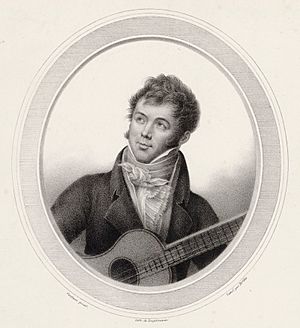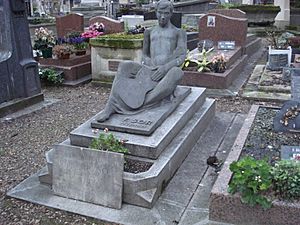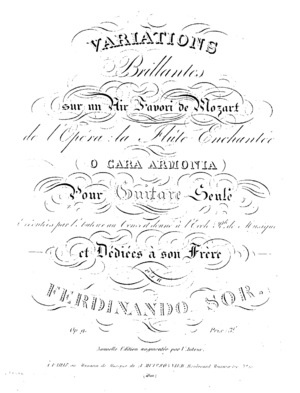Fernando Sor facts for kids
Quick facts for kids
Fernando Sor
|
|
|---|---|

A lithographed painting of Fernando Sor, c. 1825
|
|
| Born |
José Fernando Macario Sors
|
| Baptized | 14 February 1778 |
| Died | 10 July 1839 (aged 61) |
| Occupation | Composer, classical guitarist |
Fernando Sor (born February 14, 1778, died July 10, 1839) was a famous Spanish classical guitarist and composer. He lived during the early Romantic period. Sor is best known for his amazing music for solo classical guitar.
He also wrote an opera when he was just 19 years old. His other works include three symphonies, music for two guitars, piano pieces, songs, and a Mass. He also created two very popular ballets: Cinderella and Hercule et Omphale. Cinderella was performed over a hundred times!
Fernando Sor was an incredible guitar player. Many people thought he was the best in the world. Because he was so good, he wrote music for guitar players of all skill levels. His studies and exercises, like Op. 6, Op. 29, Op. 31, and Op. 35, have been played for 200 years. They are still printed and used today. However, some of his music, like his famous Introduction and Variations on Mozart's "Das klinget so herrlich" Op. 9, is very challenging to play.
Unlike modern guitarists, Sor used smaller, slimmer "Romantic" guitars. These were different from the larger guitars we see today. He rarely used his ring finger when plucking the strings, and only for chords, not for melodies. He also chose not to use his fingernails when playing.
Contents
What's in a Name?
Fernando Sor's name was spelled in different ways as his music was published in various countries. You might see it as Joseph Fernando Macario Sors, Ferdinand Sor, Ferdinando Sor, or even Ferran Sor. Even though his family name appeared in different forms, the oldest documents show it as "Sor." This is the name he is most known by.
About His Life
Early Life in Spain
Fernando Sor was born in Barcelona into a well-off family. He was baptized as José Fernando Macario Sors. However, on most of his music, his name appears as Fernando Sor or Ferdinand Sor.
Sor came from a family of soldiers and was expected to follow in their footsteps. But his father introduced him to Italian opera, and Fernando fell in love with music. He decided to become a musician instead of a soldier. His father also introduced him to the guitar.
When he was young, Sor's parents didn't pay too much attention to his musical talent. They worried it would distract him from his Latin studies. So, young Sor, who was not yet 11, started writing songs using Latin words to impress them. He even made up his own way to write music notes because he hadn't had formal training yet.
When he was about 11 or 12, the leader of the Barcelona Cathedral noticed his talent. Fernando was enrolled in the school there. Soon after, his father died, and his mother didn't have enough money to keep him in the Cathedral school.
Around the same time, Joseph Arredondo, a new abbot, heard about Sor's talent. He provided money for Fernando to attend the choir school at the famous Santa Maria de Montserrat monastery. Sor later wrote that he loved this place and had many happy memories of his childhood there.
However, his mother saw that music was distracting him from his military or administrative path. Following advice from friends, she took him out of the monastery. She placed him in military school for four years. This wasn't a bad thing, as he still had plenty of free time to play and compose music in the army.
In 1808, when Napoleon Bonaparte invaded Spain, Sor began writing patriotic music for the guitar. These songs often had lyrics that supported Spain. Sor even joined traveling military bands that played protest music in the streets. He became a captain in Córdoba and might have fought against the French.
However, after the Spanish army was defeated, Sor took a job in the French government that was occupying Spain. Because of this, he was called an afrancesado. This term was used for Spaniards who supported the ideas of the French Revolution. When the Spanish drove out the French in 1813, Sor and other afrancesados left Spain. They were afraid of being punished. He went to Paris and never returned to his home country.
Life in Paris, London, and Moscow
After giving up his family's dream of a military career, Sor could finally focus on music in France. He first became known as a brilliant guitarist and composer for the instrument. However, when he tried writing operas, the French didn't like them. His Op. 7 was a long and unusual piece, and no guitarist at the time could play it. Since France wasn't supporting his music, Sor decided to try his luck elsewhere.
In 1815, he moved to London to build a stronger music career. Again, he became very famous as a classical guitarist. He also gave guitar and singing lessons. Since ballet was more popular than opera in London, Sor decided to try composing for ballet. He was very successful this time, especially with his ballet Cendrillon (Cinderella).
By 1823, after gaining fame in London, Sor moved again. This time he went to Moscow with his wife, the ballerina Félicité Hullin. She wanted to become a top ballerina there. Not much is known about his time in Moscow. After three years, he traveled around Europe, giving concerts and meeting other musicians.
In 1827, partly because he was getting older, he decided to settle down. He chose to live the rest of his life back in Paris. It was during this time that he composed most of his classical guitar works. He had to create music that the public wanted, which was often technically simple and pleasant to listen to. In his last ten years, his writings show he was a bit unhappy with how his music was received. For example, he titled one piece Op. 43 Mes Ennuis ("My Annoyances"). He also dedicated six of his ballets to "whoever wants them." These sarcastic comments didn't help his music sales. The introduction to Op. 45 was even more direct: "Let's see if that's that. Six short and easy pieces in stages, which aim to lead to what has generally been agreed are difficulties. Composed and dedicated to the person with the least patience, by Fernando Sor. Opus 45."
His very last work was a mass written to honor his daughter, who died in 1837. This sad event made the already sick Sor very depressed. He died in 1839 from tongue and throat cancer.
What People Said About Him
The famous music historian François-Joseph Fétis called Fernando Sor "the Beethoven of the guitar."
His Music
Famous Compositions
One of Sor's most popular pieces is his Introduction and Variations on a Theme by Mozart, Op. 9. This piece is based on a well-known melody from Mozart's opera The Magic Flute. The melody is called "Das klinget so herrlich, das klinget so schön!" (which means "That sounds so lovely, that sounds so beautiful!").
Music for Learning
Sor was a very productive composer and quite popular in his time. There was a big demand for him to write music that less experienced players could enjoy. The instructional studies he created are not only valuable for guitar students but are also beautiful pieces of music themselves. Much of this work is organized into different collections (called opus numbers), usually getting harder as the numbers go up:
- Op. 60 (25 lessons)
- Op. 44 (24 lessons)
- Op. 35 (24 exercises)
- Op. 31 (24 lessons)
- Op. 6 (12 studies)
- Op. 29 (12 studies)
His Guitar Method Book
Sor's book, Méthode pour la Guitare, was first published in Paris in 1830. It was later translated into English in 1832 as Method for the Spanish Guitar.
Guitars Sor Used
Sor definitely played guitars made by René François Lacôte, a French maker. Sor said that Lacôte was the only person who was open to new ideas. Some of Lacôte's guitars even have Sor's signature on them. One of these guitars is on display at the Metropolitan Museum of Art.
In his method book, Sor also mentioned other guitar makers he liked. He said, "If I wanted an instrument, I would get it from M. Joseph Martinez of Malaga, or from M. Lacote." He also preferred guitars from Alonzo of Madrid, Pagès and Benediz of Cadiz, Joseph and Manuel Martinez of Malaga, or Rada. He also mentioned that J. Panormo of London and Mr. Schroeder of Petersburgh made some guitars following his ideas.
The famous guitarist Andrés Segovia chose 20 of Sor's studies. Each study focuses on a different playing technique. These studies are now some of Fernando Sor's most well-known works.
Selected Recordings
- Fernando Sor: Complete Studies for Guitar, performed by Enea Leone, on: Brilliant Classics 94791 (triple CD, 2014). This includes all of his Opp. 6, 29, 31, 35, 44, and 60.
See also
 In Spanish: Fernando Sor para niños
In Spanish: Fernando Sor para niños





